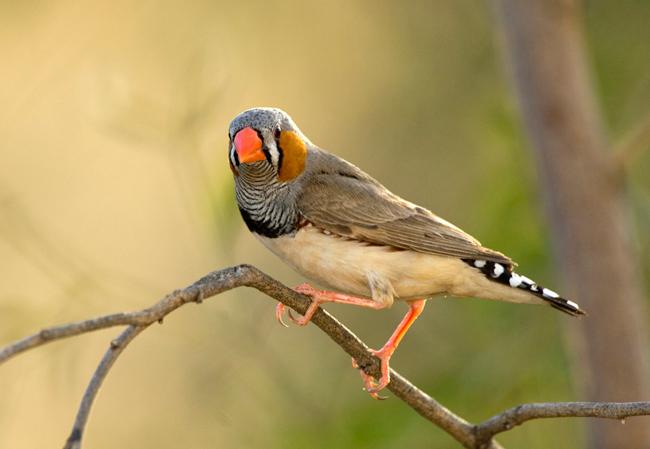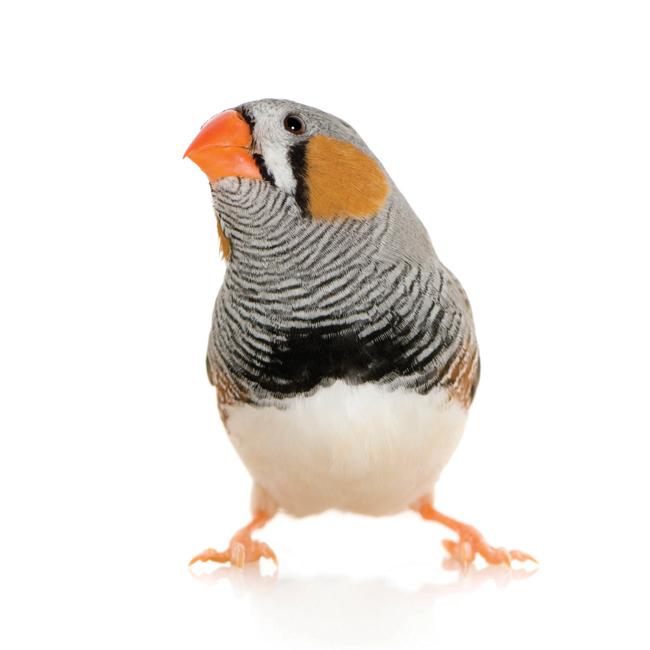Field Notes
A fascination with baby babble leads a pediatrician to birdsong
- Feature

At well-baby visits, when it’s too early to ask about spoken words, I always ask about babble.
You want to hear that a four-month-old is producing babbling noises, heavily oriented toward vowel sounds. You hope that by around seven months, the baby is progressing to “canonical babbling,” which involves the production of what sounds like syllables, complete with consonants: ba, da, ma.
Why worry about a baby who doesn’t babble?
She may be signaling that there’s something getting in the way of speech development—a hearing problem or a general developmental delay. And to parse a baby’s silence, you would surely ask the medical students or the residents, “If the baby’s hearing is perfect, and the baby’s development seems absolutely normal, what should be your next concern about this baby who isn’t babbling?”
You would pause, hoping someone says, “Is anybody talking to her?”
You then would review how much goes into those deceptively simple baby noises—sensory, motor, cognitive, social—and how many things can go wrong.
A couple of years ago, thinking about these exam room interactions, I reviewed some of the scientific literature on human baby babble, a topic that has attracted researchers interested in speech and hearing as well as those interested in learning and the brain. Babies must learn to talk; their bodies and brains are, in fact, designed to learn this skill. Speech acquisition is a miracle of interlocking systems, ranging from the muscle control and laryngeal gymnastics involved in producing immature sounds, to the iterative process of refining those sounds into recognizable words, to the cognitive work of arranging those words into sentences and weaving those utterances into social interactions and relationships. If something goes wrong—in oral-motor muscles’ coordination or development, in acoustic and auditory processing, in cognition and memory formation, or in social stimulation—speech and language may be absent or delayed, putting the child at risk of isolation from the give and take needed to be a member of a family, a part of a culture, and ultimately, an engaged citizen of society and the world.
To further explore the science of babble, I spoke to experts who study speech and hearing, and learned about experiments that attempt to sort out how babies use their muscles to create sounds, and how they then practice repetition to bring those sounds closer to speech. Other researchers described the ways babies mimic the sounds they hear and mentioned the importance of the deliberate, exaggerated speech that has been called “motherese,” or “parentese.” Neuroscientists looking at speech see the connections between auditory and motor areas in the human brain, and study how babies learn by trial and error the oral-motor differences between producing specific meaningful sounds.
All of this made sense; these avenues of inquiry converged again on those exam room questions and concerns over sensory, motor, cognitive, and social development. But what I hadn’t expected was that so many of those roads also led to birdsong. Or that birdsong would present so many answers, and new questions.
Voice Lessons
Many animals make sounds of a predetermined, characteristic nature no matter how they are raised—even if raised in isolation or with a different species. They are, in short, wired for their sounds. Babies and many songbirds, by comparison, have the muscular hardware and the neural software for making sounds, but the specific speech and song they produce are heavily dependent on learning.

Like humans, songbirds have critical developmental periods during which they are able to learn to reproduce the sounds made by those around them. Cross-fostering experiments have shown that many types of birds raised in a different family or species can reproduce, with some constraints, the songs they hear, not the songs of their biological origins. And of course, it doesn’t matter where a human baby is born, or what language that baby’s biological parents speak; the baby will learn to speak the language he grows up hearing.
Researchers have long been fascinated by the parallels between the imperfect, immature songs of young birds and the early attempts at speech made by human babies.
“From the perspective of human speech development, the early stages of learning are the most interesting, when both birds and humans go through a stage of babbling, uttering highly variable vocalizations,” says Bence Ölveczky, the John L. Loeb Associate Professor of the Natural Sciences at Harvard University. Ölveczky studies motor learning in animals, including song production by birds. He is particularly interested in the basal ganglia, which play an important role in the bird’s ability to go from vocal experimenting, the equivalent of babble, to producing mature song.
For those experiments, Ölveczky studies zebra finches, songbirds most often found in Australia. Although smaller than your closed fist, these birds are loud and lusty singers, even in captivity. Or at least the males are. As with many songbird species, the males sing, learning their songs from their fathers, but the females do not.
Ölveczky calls zebra finches “expert animals,” pointing out that their brains are specialized for learning the complex song sequences they produce. “We can learn a lot from expert animals,” he says. “They have evolved dedicated neural circuitry optimized for a particular task. As mammals, for example, we are more generalist animals, our brains are less differentiated, we’re sort of half good at a lot of things. Birds have much more differentiated brains. They’re experts.”
Takao Hensch, an HMS professor of neurology, studies the mechanisms of critical periods of brain development, the windows of time when the brain is particularly sensitive to experience. His laboratory is looking at mice to see what turns these critical periods on and off.
According to Hensch, much important information on critical periods has come from birds. The song of the zebra finch, once learned, is crystallized for life. “Other birds, like canaries, are seasonal singers and repeat this process annually,” he says. “That’s how neurogenesis in the brain was discovered—certain songbirds reopen the critical period, and they actually have a rebirth of neurons.”
Allison Doupe ’79, a professor of psychiatry at the University of California, San Francisco, has also studied the cortical basal ganglia pathway in zebra finches. Her research team has focused on this particular part of the brain because in birds, as in humans, the basal ganglia are essential for learning and controlling movements—including the complex set of movements needed to produce a characteristic mature song.
“We study songbirds because they are vocal learners and because they have brain areas specialized for producing the song and for learning the song,” says Mimi Kao, a postdoctoral fellow at UCSF who is part of Doupe’s research team. “If you have a juvenile bird with a damaged circuit, the bird will never produce a good copy of the song.”
Doupe and her colleagues have looked at the neuronal detail of the pathway—recording the activity in the brain while the bird is singing and then examining the patterns of neuron firing—and have demonstrated that these patterns are highly sensitive to social context and to the stimulation that the bird receives.

“When males are singing by themselves, the brain activity varies from one song to the next,” says Kao. “When a male sings to a female and he’s singing the same song, the activity looks much more stereotyped and precise.”
Or, as Doupe and Patricia Kuhl, a professor in the Department of Speech and Hearing Sciences at the University of Washington, Seattle, put it in a landmark article published in the Annual Review of Neurosciencein 1999, “the social factors required by zebra finches can come in a variety of modalities, all of which may serve to open some attentional or arousal gate, which then permits sensory learning.” They went on to write, “Infants engaged in social interaction appear to be highly aroused and attentive, which may play a role in their ability to react to and learn socially significant stimuli.”
Duets
So, babble matters, and birdsong is important for thinking about babble—as model, as mechanism, even as metaphor. People who study baby babble and those who study birdsong are aware of the neurological parallels. There are “baby researchers” who cite birdsong, and “bird researchers” who cite babble.
I talked with Michael Goldstein, who cites, and studies, both.
Goldstein is an associate professor of psychology at Cornell University. In a building on that campus, he and Jennifer Schwade, a research associate, run the Behavioral Analysis of Beginning Years lab. Yes, the B.A.B.Y. lab. Upstairs, they study human infants, and adults; downstairs they study young and mature zebra finches. I spent a couple of days in that building, moving from floor to floor, watching the researchers study the babies and listening to the songs of the finches.
In the upstairs lab, the researchers conduct baby-parent studies, looking at the ways that babies elicit speech from their parents and how the social context of this kind of back and forth affects the baby’s skill as a learner of speech and language. Downstairs, they study zebra finches, concentrating on how social interactions shape the vocal learning that produces the song.
Thus, two very strong strands of inquiry twist together: the people who look at what is called song production in the birds are the same people who look at how human babies learn to master and interpret the language of the world around them.
Much of what the researchers study in the human babies concerns the effect that the mother’s responses have on the baby’s vocalizations and on vocal learning. “The caregiver reacts,” says Goldstein, “and the infant modifies the sounds. As the sounds become more speechlike, the caregiver is more likely to react. So babbling has a crucially important function, but you’re only going to see it if you study babbling in a social context.”

It turns out it’s also best to study the birds in a social context. Goldstein’s team studies the ways that adult birds, both males and females, react to immature birdsong, and the ways that those reactions shape a young bird’s learning. This involves studying not only the song that a father, or other adult male, may produce, but also the behaviors, such as wing movements and so-called fluff-ups, that convey a response from a mother or other avian female. Upstairs and downstairs, development is studied as part of a social system, in which a young learner’s immature utterances elicit responses that then help the vocalizations develop and mature.
Score Marking
All of the researchers I contacted are people who love to think about the whys and wherefores of human speech. Talking with them or reading their research takes you from brain structure and function to learning and memory, and from statistical learning—the neurological mathematics of frequency, the process by which babies’ brains figure out parts of speech and syntax—to how simple mechanisms, such as parental responses to a baby’s sounds, can help generate complex communications.
While at Cornell, I listened carefully to the songs of the zebra finches as the researchers pointed out the immature, plastic song of young birds and the mature song of the adults, song that has been shaped by stimulation and social interaction. Now, in the clinic, I again listen carefully—and, perhaps, with added awe—to babies as they babble their way toward language and communication.
Perri Klass ’86 is a professor of journalism and pediatrics and director of the Arthur L. Carter Journalism Institute at New York University.
Images: iStock (top); Kathie Atkinson/AUSCAPE, All rights reserved (zebra finches); Steven David Miller/AUSCAPE, All rights reserved (single finch); iStock (silhouette)